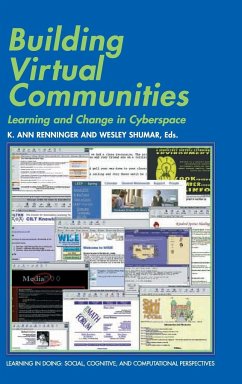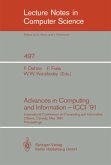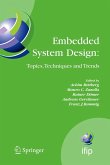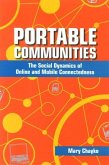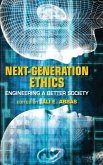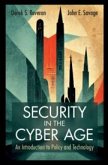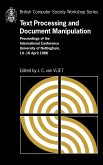K. Renninger / Wesley Shumar (eds.)
Building Virtual Communities
Herausgeber: Renninger, K. Ann; Shumar, Wesley
K. Renninger / Wesley Shumar (eds.)
Building Virtual Communities
Herausgeber: Renninger, K. Ann; Shumar, Wesley
- Gebundenes Buch
- Merkliste
- Auf die Merkliste
- Bewerten Bewerten
- Teilen
- Produkt teilen
- Produkterinnerung
- Produkterinnerung
Building Virtual Communities examines how learning and cognitive change are fostered by online communities.
Andere Kunden interessierten sich auch für
![Advances in Computing and Information - ICCI '91 Advances in Computing and Information - ICCI '91]() Frank Dehne / Frantisek Fiala / Waldemar W. Koczkodaj (eds.)Advances in Computing and Information - ICCI '9177,99 €
Frank Dehne / Frantisek Fiala / Waldemar W. Koczkodaj (eds.)Advances in Computing and Information - ICCI '9177,99 €![Embedded System Design: Topics, Techniques and Trends Embedded System Design: Topics, Techniques and Trends]() Achim Rettberg / Mauro Zanella / Rainer Domer / Andreas Gerstlauer / Franz Rammig (eds.)Embedded System Design: Topics, Techniques and Trends75,99 €
Achim Rettberg / Mauro Zanella / Rainer Domer / Andreas Gerstlauer / Franz Rammig (eds.)Embedded System Design: Topics, Techniques and Trends75,99 €![Portable Communities Portable Communities]() Mary ChaykoPortable Communities96,99 €
Mary ChaykoPortable Communities96,99 €![Next-Generation Ethics Next-Generation Ethics]() Next-Generation Ethics112,99 €
Next-Generation Ethics112,99 €![Security in the Cyber Age Security in the Cyber Age]() Derek S ReveronSecurity in the Cyber Age81,99 €
Derek S ReveronSecurity in the Cyber Age81,99 €![Computing the Climate Computing the Climate]() Steve M EasterbrookComputing the Climate78,99 €
Steve M EasterbrookComputing the Climate78,99 €![Text Processing and Document Manipulation Text Processing and Document Manipulation]() J. C. van Vliet (ed.)Text Processing and Document Manipulation88,99 €
J. C. van Vliet (ed.)Text Processing and Document Manipulation88,99 €-
-
-
-
-
Building Virtual Communities examines how learning and cognitive change are fostered by online communities.
Produktdetails
- Produktdetails
- Verlag: Cambridge University Press
- Seitenzahl: 414
- Erscheinungstermin: 3. Februar 2016
- Englisch
- Abmessung: 235mm x 157mm x 29mm
- Gewicht: 820g
- ISBN-13: 9780521780759
- ISBN-10: 0521780756
- Artikelnr.: 22720469
- Herstellerkennzeichnung
- Libri GmbH
- Europaallee 1
- 36244 Bad Hersfeld
- gpsr@libri.de
- Verlag: Cambridge University Press
- Seitenzahl: 414
- Erscheinungstermin: 3. Februar 2016
- Englisch
- Abmessung: 235mm x 157mm x 29mm
- Gewicht: 820g
- ISBN-13: 9780521780759
- ISBN-10: 0521780756
- Artikelnr.: 22720469
- Herstellerkennzeichnung
- Libri GmbH
- Europaallee 1
- 36244 Bad Hersfeld
- gpsr@libri.de
Preface K. Ann Renninger and Wesley Shumar; Foreword: virtual communities
for learning and development: a look to the past and some glimpses into the
future Michael Cole; Introduction: on conceptualizing community Wesley
Shumar and K. Ann Renninger; Part I. Types of Community: 1. The mystery of
the death of Mediamoo: seven years of evolution of an online community Amy
Bruckman and Carlos Jensen; 2. Female voices in virtual reality: drawing
young girls into an on-line world Ann Locke Davidson and Janet Ward
Shofield; 3. Community building with and for teachers at the math forum K.
Ann Renninger and Wesley Shumar; 4. Learning in the virtual community
depends upon changes in local communities Beverly Hunter; Part II.
Structure and Community: 5. Evolution of an on-line education community of
practice Mark S. Schlager, Judith Fusco and Patricia Schank; 6. Building
social networks via computer networks: creating and sustaining distributed
learning communities Caroline Haythornthwaite; 7. Mask and identity: the
hermeneutics of self construction in the information age Dorian Wiszniewski
and Richard Coyne; 8. WISE learning communities: design considerations Alex
J. Cuthbert, Douglas B. Clark and Marcia C. Linn; Part III. Possibilities
for Community: 9. Reflexive modernization and the emergence of wired
self-help Roger Burrows and Sarah Nettleton; 10. Understanding the
lifecycles of network-based learning communities James Levin and Raoul
Cervantes; 11. Learning in cyberspace: an educational view of virtual
community D. Jason Nolan and Joel Weiss; 12. Finding the ties that bind:
tools in support of a knowledge-building community Christopher M. Hoadley
and Roy D. Pea; Afterword: building our knowledge of virtual community:
some responses David Hakken; Afterword: building, buying, or being there:
imagining online community Steven G. Jones.
for learning and development: a look to the past and some glimpses into the
future Michael Cole; Introduction: on conceptualizing community Wesley
Shumar and K. Ann Renninger; Part I. Types of Community: 1. The mystery of
the death of Mediamoo: seven years of evolution of an online community Amy
Bruckman and Carlos Jensen; 2. Female voices in virtual reality: drawing
young girls into an on-line world Ann Locke Davidson and Janet Ward
Shofield; 3. Community building with and for teachers at the math forum K.
Ann Renninger and Wesley Shumar; 4. Learning in the virtual community
depends upon changes in local communities Beverly Hunter; Part II.
Structure and Community: 5. Evolution of an on-line education community of
practice Mark S. Schlager, Judith Fusco and Patricia Schank; 6. Building
social networks via computer networks: creating and sustaining distributed
learning communities Caroline Haythornthwaite; 7. Mask and identity: the
hermeneutics of self construction in the information age Dorian Wiszniewski
and Richard Coyne; 8. WISE learning communities: design considerations Alex
J. Cuthbert, Douglas B. Clark and Marcia C. Linn; Part III. Possibilities
for Community: 9. Reflexive modernization and the emergence of wired
self-help Roger Burrows and Sarah Nettleton; 10. Understanding the
lifecycles of network-based learning communities James Levin and Raoul
Cervantes; 11. Learning in cyberspace: an educational view of virtual
community D. Jason Nolan and Joel Weiss; 12. Finding the ties that bind:
tools in support of a knowledge-building community Christopher M. Hoadley
and Roy D. Pea; Afterword: building our knowledge of virtual community:
some responses David Hakken; Afterword: building, buying, or being there:
imagining online community Steven G. Jones.
Preface K. Ann Renninger and Wesley Shumar; Foreword: virtual communities
for learning and development: a look to the past and some glimpses into the
future Michael Cole; Introduction: on conceptualizing community Wesley
Shumar and K. Ann Renninger; Part I. Types of Community: 1. The mystery of
the death of Mediamoo: seven years of evolution of an online community Amy
Bruckman and Carlos Jensen; 2. Female voices in virtual reality: drawing
young girls into an on-line world Ann Locke Davidson and Janet Ward
Shofield; 3. Community building with and for teachers at the math forum K.
Ann Renninger and Wesley Shumar; 4. Learning in the virtual community
depends upon changes in local communities Beverly Hunter; Part II.
Structure and Community: 5. Evolution of an on-line education community of
practice Mark S. Schlager, Judith Fusco and Patricia Schank; 6. Building
social networks via computer networks: creating and sustaining distributed
learning communities Caroline Haythornthwaite; 7. Mask and identity: the
hermeneutics of self construction in the information age Dorian Wiszniewski
and Richard Coyne; 8. WISE learning communities: design considerations Alex
J. Cuthbert, Douglas B. Clark and Marcia C. Linn; Part III. Possibilities
for Community: 9. Reflexive modernization and the emergence of wired
self-help Roger Burrows and Sarah Nettleton; 10. Understanding the
lifecycles of network-based learning communities James Levin and Raoul
Cervantes; 11. Learning in cyberspace: an educational view of virtual
community D. Jason Nolan and Joel Weiss; 12. Finding the ties that bind:
tools in support of a knowledge-building community Christopher M. Hoadley
and Roy D. Pea; Afterword: building our knowledge of virtual community:
some responses David Hakken; Afterword: building, buying, or being there:
imagining online community Steven G. Jones.
for learning and development: a look to the past and some glimpses into the
future Michael Cole; Introduction: on conceptualizing community Wesley
Shumar and K. Ann Renninger; Part I. Types of Community: 1. The mystery of
the death of Mediamoo: seven years of evolution of an online community Amy
Bruckman and Carlos Jensen; 2. Female voices in virtual reality: drawing
young girls into an on-line world Ann Locke Davidson and Janet Ward
Shofield; 3. Community building with and for teachers at the math forum K.
Ann Renninger and Wesley Shumar; 4. Learning in the virtual community
depends upon changes in local communities Beverly Hunter; Part II.
Structure and Community: 5. Evolution of an on-line education community of
practice Mark S. Schlager, Judith Fusco and Patricia Schank; 6. Building
social networks via computer networks: creating and sustaining distributed
learning communities Caroline Haythornthwaite; 7. Mask and identity: the
hermeneutics of self construction in the information age Dorian Wiszniewski
and Richard Coyne; 8. WISE learning communities: design considerations Alex
J. Cuthbert, Douglas B. Clark and Marcia C. Linn; Part III. Possibilities
for Community: 9. Reflexive modernization and the emergence of wired
self-help Roger Burrows and Sarah Nettleton; 10. Understanding the
lifecycles of network-based learning communities James Levin and Raoul
Cervantes; 11. Learning in cyberspace: an educational view of virtual
community D. Jason Nolan and Joel Weiss; 12. Finding the ties that bind:
tools in support of a knowledge-building community Christopher M. Hoadley
and Roy D. Pea; Afterword: building our knowledge of virtual community:
some responses David Hakken; Afterword: building, buying, or being there:
imagining online community Steven G. Jones.

